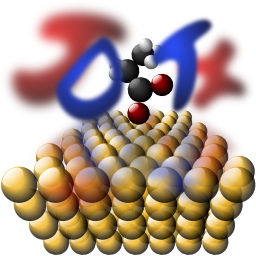
|
JDFTx is a plane-wave density functional code designed for Joint Density Functional Theory (JDFT), a framework for ab initio calculations of electronic systems in contact with liquid environments. It is distributed under the GPL license (version 3 or higher) and publications resulting from its use must cite the following:
For any given calculation, JDFTx prints out a list of relevant citations for optional features of the code used in that run. This output appears at the end of initialization just before the first electronic solve starts.
JDFTx evolved from an earlier in-house research code in the Arias research group at Cornell called DFT++, but at this point has been almost entirely rewritten in a modern object oriented framework taking advantage of C++11 for expressive code with advanced memory management, and CUDA for leveraging the computational power of GPUs. See [Compiling] for details on unlocking various features.
Unlike most other electronic structure codes, JDFTx performs total energy minimization using analytically continued energy functionals implemented within the algebraic formulation described in the above references, rather than density-mixing SCF schemes. Hence our motto "Our SCF never diverges, because we don't do SCF". This might be advantageous for vanilla DFT calculations in some cases (try your problematic systems out!), but it is quite important for reliable convergence in the presence of liquids, particularly with charged systems.
The framework of Joint Density functional theory is described in:
which should be cited for work using any of the fluid models. A polarizable continuum-like solvation approach which replaces the fluid by a local dielectric response is also described in that paper. The capability for handling charged systems and absolute voltage references for electrochemistry is added by incorporating ionic screening in the fluid according to:
Recently reparametrized versions of the polarizable continuum model which include cavitation and dispersion terms and allow for nonlinear dielectric and ionic response according to
The full power of Joint Density functional theory is unleashed when the electronic density functional is coupled to an explicit classical free energy functional for the fluid. The coupling is typically achieved using density-only electronic functionals as described in
and available functionals for water include
JDFTx also incorporates advanced algorithms for converging metallic systems with finite temperature Fermi function fillings, critical for the study of electrochemical systems. Our implementation extends an analytically continued free energy functional version of the joint orbital and occupation minimization scheme,
to include minimization at constant chemical potential.
JDFTx also supports solvating Quantum Monte Carlo (QMC) calculations, by producing trial wavefunctions and external potentials for use in the QMC software CASINO, as described in:
Please check back here (or in the code output after upgrading to the latest version) for updates on citations that are under preparation.
| This material is based upon work supported as part of the Energy Materials Center at Cornell (EMC2), an Energy Frontier Research Center funded by the U.S. Department of Energy, Office of Science, Office of Basic Energy Sciences under Award Number DE-SC0001086. | 
|